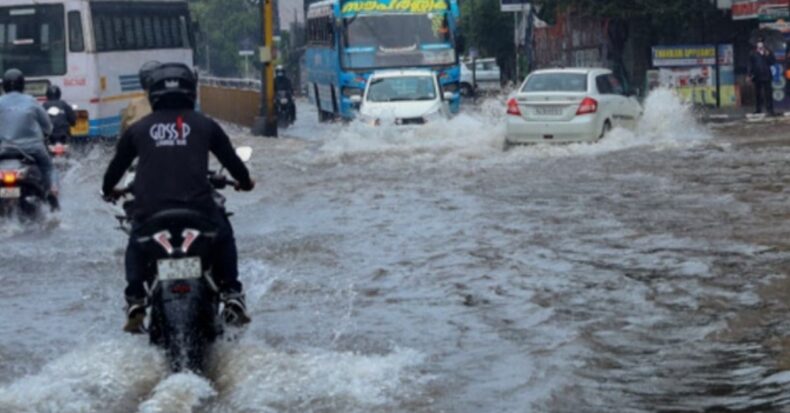Kerala experiences heavy rainfall during October and showing the time for silver and Saturn to be extra vigilant as low pressures in the Bay of Bengal and the Arabian Sea in the west, like twin machines, swirl the vapor and drown the state in torrential downpours.
The low-pressure area in the southern part of Kerala in the Arabian Sea often causes havoc as it passes through the state. But it is not uncommon for Kerala to form along with Lakshadweep, which is happening now.
By October 17, another low-pressure area is forming in the Bay of Bengal. With this, this month will have the distinction of being the rainy October every day.
Rains intensify in Central Kerala.
Although the low-pressure area currently prevailing in the Bay of Bengal will not directly affect Kerala, it will indirectly increase rainfall intensity. The second low-pressure is forming in the Arabian Sea near Lakshadweep, and it will reach the coast along the coast of Kerala within 24 hours and directly affect Kerala.
By the 16th, as the two twin brothers gain the same latitude, the rainfall will increase in the country’s center. One pulls east, and the other moves west.
The kinetic energy from both will bring heavy clouds over Kerala. It was such a low-pressure meeting that caused the floods of 2018. As per the present conclusion, the low pressure will open the way for heavy rains in Malappuram and Palakkad districts.
Fishing banned; Orange and Yellow Alert.
Until May 16, the Central Meteorological Department had issued a stern warning prohibiting fishing. Palakkad and Malappuram districts are heading with orange alert on the 15th and in Malappuram, Kozhikode, Wayanad, and Kannur districts on the 16th.
Extreme levels of rainfall of up to 20 cm in 24 hours are expecting. Some amateur meteorologists are concerned that this may also cause small movements induced by tornadoes, especially in the case of soil erosion.
Chance of a Thunderstorm
The Central Meteorological Department has forecast strong winds in Kerala till October 18. Following are the public vigilance instructions issued by the State Disaster Management Authority to deal with strong winds: –
Steps to be taken by the people
1. Strong winds are the most devastating and deadly state disaster in Kerala. Under wind or rain for any reason. Do not park vehicles in trees.
2. Take the initiative to cut down dangerous twigs of trees in the backyard. Inform the concerned local bodies about dangerous trees in public places.
3. Unscrewed billboards, power posts, flagpoles, etc., should be adequately reinforced or loosened in case of wind and rain as there is a risk of falling trunks. Do not stand or park under or near vehicles during rainy and windy seasons.
4. Equipment and other objects that may fall in the wind, such as a ladder leaning against a wall or other entity, should be tied with rope.
5. The windows and doors of the house should be closed as soon as the wind starts blowing. Do not stand near windows and doors, and avoid standing on the terrace of the house.
6. Those living in dilapidated, sheet-lined, or unsealed houses should contact the authorities (on 1077) in advance and move to safer buildings as and when required in the event of a warning.
7. Local Self Government Institutions, Revenue Officers, and People’s Representatives should take the initiative to transfer such persons identified under the Local Government Level Disaster Mitigation Scheme to the relief camps as and when required following the Code of Conduct 19.
8. Power lines and posts are more likely to rupture when wind and rain are strong. In case of any such accident, immediately inform KSEB Control Room 1912 or District Disaster Management Authority Control Room on 1077.
Troubleshooting should be avoided during the windy season and only after the wind and rain have stopped. The public should cooperate patiently with KSEB employees and not do such repair work directly in public.
9. Those who work early in the morning, such as newspaper and milk distributors, should be especially careful and ensure that the power line does not break due to flooding of roads. If you suspect any danger, you should inform the control room and proceed only after ensuring no threat.
10. Ensure that power lines passing through farms are safe before entering the field.
11. Those engaged in construction should stop their work and move to a safer place when the wind and rain are strong.
12. Please note that the forecast of rain and thundershowers for the next 3 hours will be updated at regular intervals on the website of the Central Meteorological Department at https://www.imdtvm.gov.in/. Strictly follow the guidelines of the Disaster Management Authority.












